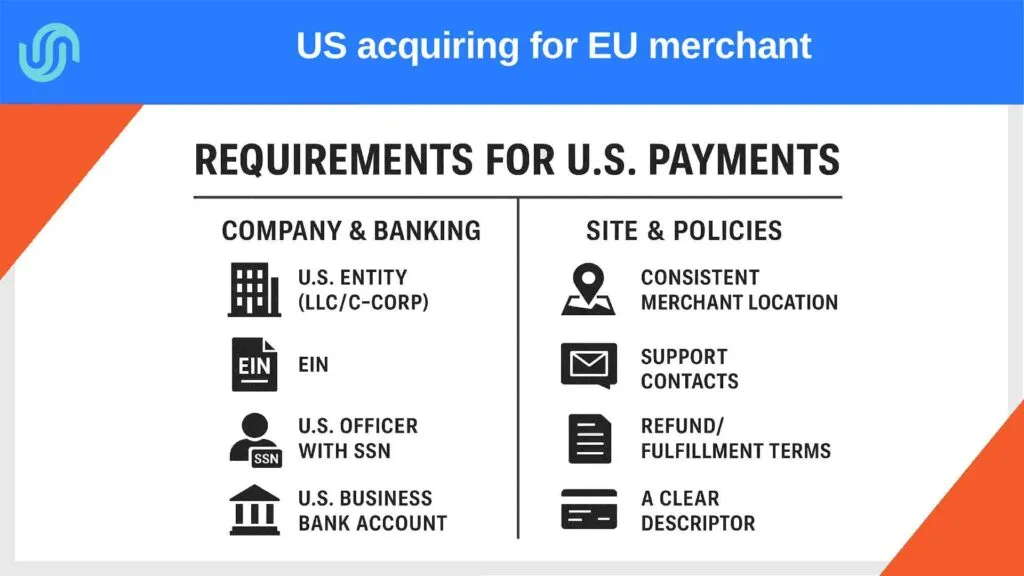TL;DR. If a European merchant pushes a lot of US-issued cards through an EU acquirer, the traffic looks cross-border to the issuer and approval rates drop. Local US acquiring and US-native rails (ACH, RTP, FedNow) usually lift conversions and cut costs. Visa also expects correct merchant location data in the auth/clearing stream and on site, which is easier when you process domestically. Rule of thumb: when 70–80%+ of your payers are US, US domestic becomes a near must-have. It means you need to think about US domestic acquiring for EU merchant ASAP.
The problem (and why it hurts conversion)
Cross-border signal → lower approvals. Issuers see a country mismatch (cardholder US, merchant/acquirer EU). Global processors openly state that local acquiring improves authorization rates and can lower scheme/interchange costs (see, e.g., Adyen docs).
Disclosure & data quality matter. Visa highlights providing the proper location of the merchant business to support issuer decisions and reduce disputes. Inconsistent merchant-location data increases friction (Visa).
The solutions (pick one or combine)
1) Go domestic: a US MID with a US acquirer/PSP
For a true US domestic setup, most providers expect a US legal entity + US bank account and a verifiable TIN (EIN/SSN/ITIN). Stripe’s US account docs are a typical example. Result: “native” routing and better issuer recognition (Stripe Support). This is the best approach to get US domestic acquiring for EU merchant.
2) Use a global PSP that offers local US acquiring to non-US entities
Several global platforms can place you on their US rails even if your company is EU-based—availability depends on country, MCC, risk profile, and volume. Expect to be nudged to a US entity as you scale (Adyen).
3) Add US-native payment rails alongside cards
- ACH (incl. Same Day ACH) for subscriptions/invoicing; enormous coverage and mature rails (Nacha).
- RTP® (The Clearing House) for real-time credits; instant, 24/7 finality through participating banks (The Clearing House).
- FedNow® (Federal Reserve) where supported by your bank/service provider for 24×7×365 instant credits (FRB Services).
Practical checklist (what you actually need)
Company & banking
US entity (LLC/C-Corp) + EIN; control person with SSN or, for non-residents, an acceptable ITIN/ID path (as required by the provider). Open a US business bank account for settlement (like Stripe Support). From our experience, the first option has a much higher chance of success i.e. you need an officer with US citizenship and WiseAlt may help to find such a person in some cases.
Site & policies (reduce disputes, match data)
Publish consistent merchant location, support contacts, refund/fulfilment terms, and use a clear descriptor. Visa’s guidance on proper location explains why this matters for issuer decisions (Visa).
Auth & retry hygiene
Turn on AVS (ZIP check) and use the response to steer decisions and retries; AVS is a standard CNP control and can lift net approvals when used judiciously (Visa Acceptance Support Center).
Enable card-on-file updaters—Visa Account Updater / Mastercard ABU—to lower passive churn and soft declines (Visa • Mastercard ABU).
Alternative rails
Offer ACH for recurring/one-off invoices; evaluate RTP/FedNow for time-critical payouts/receivables (where supported) (Nacha • The Clearing House).
Smart routing: make US payments look “native”
- Detect issuer country/BIN. If
issuer = US, prefer US domestic route (US MID). Fallback to EU route only if needed. (Global processors document higher approvals on local routes — e.g., Adyen.) - Decision by AVS/CVV outcome. Approve/flag/step-up or retry with adjusted auth parameters when AVS is a partial match (Visa Acceptance KB).
- Credential lifecycle. Use VAU/ABU to auto-refresh card-on-file and prevent needless retries/declines (Visa).
- Rail switching. For recurring invoices or high-decline BINs, offer ACH at checkout (or via dunning links). For instant high-value B2B, expose RTP/FedNow requests if your bank supports them (Nacha • The Clearing House).
Cost & risk: cards vs US-native rails (quick view)
- Cards (US domestic): best reach, higher scheme fees; tune AVS, network tokens, account updaters to reduce declines (Visa).
- ACH: low fees, batch settlement, return windows; great for subscriptions/invoicing (Nacha).
- RTP/FedNow: instant, credit-push, irrevocable; powerful for payouts/just-in-time collection where supported (The Clearing House • FRB Services).
Who benefits most (including high-risk)
SaaS and marketplaces with US users, cross-border e-commerce, and regulated/high-risk verticals that need to raise US authorization rates while controlling disputes: weave in high-risk merchant account, high-risk payment processing, high-risk payment gateway, high-risk credit card processing, chargeback prevention for high-risk, high-risk e-commerce solutions, fraud prevention high-risk, high-risk industry processing, offshore merchant accounts for high-risk, iGaming payment processing, iCasino payment processing, betting payment processing, crypto payment processing, traveling payment processing, logistics payment processing—and map each to the rails and controls above.
KPIs to track after the switch
- US auth rate (by BIN, by acquirer route)
- Soft-decline recovery (retry uplift with AVS logic + VAU/ABU hits) (Visa)
- Cost per successful order (cards vs ACH/RTP/FedNow)
- Chargeback rate and dispute win rate (after descriptor/policy fixes)
- Checkout method mix (share of ACH / instant bank payments)
